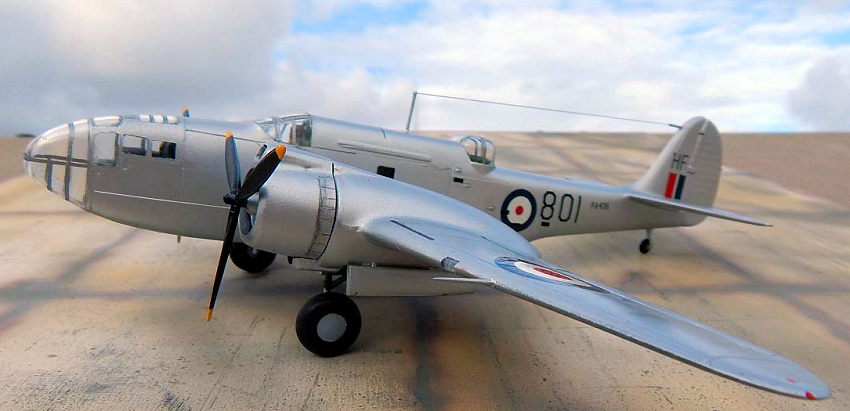
Frog 1/72 Martin Baltimore
| KIT #: | |
| PRICE: | $ |
| DECALS: | One option |
| REVIEWER: | Carmel J. Attard |
| NOTES: |

| HISTORY |
Initially designated the A-23 (derived from the A-22 Martin 167 Maryland design) , the Model 187 (company designation) had a deeper fuselage and more powerful engines. The Model 187 met the needs for a light to medium bomber, originally ordered by the Anglo-French Purchasing Commissionn as a joint project in May 1940. The French Air Forcee sought to replace the earlier Maryland; 400 aircraft being ordered. With the fall of France, the RAF took over the order and gave it the service name Baltimore. To enable the aircraft to be supplied to the British under the Lend-Lease Actt the United States Army Air Forcess designation A-30 was allocated. (With the passing of the Lend Lease Act two further batches of 575 and then 600 were provided to the RAF.)
 The first British aircraft were
delivered in late 1941 to equip Operational Training Units. The RAF only
used the Baltimores operationally in the Mediterranean theater and North
Africa.Thrown
into action to stop Rommel's advance, the Baltimore suffered massive
losses when it was utilized as a low-level attack aircraft, especially
in the chaos of the desert war where most missions went unescorted.
However, operating at medium altitude with fighter escorts, the
Baltimore had a very low loss rate, with the majority of losses coming
from operational accidents.
The first British aircraft were
delivered in late 1941 to equip Operational Training Units. The RAF only
used the Baltimores operationally in the Mediterranean theater and North
Africa.Thrown
into action to stop Rommel's advance, the Baltimore suffered massive
losses when it was utilized as a low-level attack aircraft, especially
in the chaos of the desert war where most missions went unescorted.
However, operating at medium altitude with fighter escorts, the
Baltimore had a very low loss rate, with the majority of losses coming
from operational accidents.
Undertaking a variety of missions in the Middle East, Mediterranean and European theaters, the Baltimore's roles included reconnaissance, target-towing, maritime patrol, night intruder and even served as highly uncomfortable fast transports. The Baltimore saw limited Fleet Air Arm service with aircraft transferred from the RAF in the Mediterranean to equip a squadron in 1944. Used in the anti-submarine role during the war, the Baltimore achieved moderate success, sinking up to eight U-boats.
The RAF
also transferred aircraft to other Allies in the Mediterranean area.
After the capitulation of Italy in 1943, the type was used intensively
in the Italian campaign to clear the road to Rome for
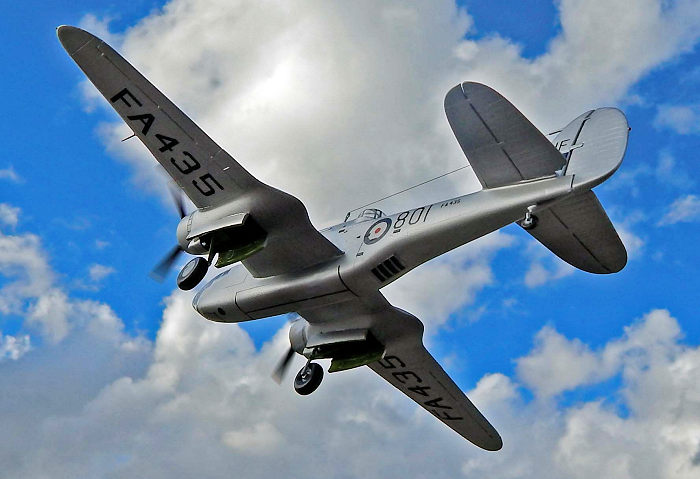 advancing Allied
forces. After the armistice, an Italian-manned squadron, the 28th Bomber
Wing, was equipped with ex-RAF Baltimores, becoming the co-belligerent
Stormo Baltimore.
The Italians suffered considerable attrition during their training phase
on the Baltimore. The majority of accidents were during takeoffs and
landings due to the aircraft's fairly high wing loading, high approach
speed and a directional stability problems during takeoffs. The Italians
only operated the Baltimore for roughly six months. Many of those
operations were in Yugoslavia and Greece, providing air support for
partisan forces or dropping supplies.
advancing Allied
forces. After the armistice, an Italian-manned squadron, the 28th Bomber
Wing, was equipped with ex-RAF Baltimores, becoming the co-belligerent
Stormo Baltimore.
The Italians suffered considerable attrition during their training phase
on the Baltimore. The majority of accidents were during takeoffs and
landings due to the aircraft's fairly high wing loading, high approach
speed and a directional stability problems during takeoffs. The Italians
only operated the Baltimore for roughly six months. Many of those
operations were in Yugoslavia and Greece, providing air support for
partisan forces or dropping supplies.
Baltimores in Malta
For a while during and after the war years the Martin Baltimore was a common type spotted over the island of Malta. In July 1943 No.223 Squadron detachment and No.55 Squadron arrived at Luqa from Reyville with Baltimores III and IV and left on 10th August to Monte Lungo. During July the situation was infinitely more static although the station at Luqa was still extreamely busy and on 31st July there were no less than 11 squadrons present, among them were those of 55Sq, 69Sq, and 223Sq all equipped with Baltimore III and IVs.
No.69 Sq was the
permanent squadron based on the siland equipped with Maryland and
Beaufort but in Mid 1942 the first six Baltimores arrived. One was
almost destroyed on the ground when a Beaufort bomber parked nearby
caught fire and its torpedoes exploded. At the end of the month the
squadron’s
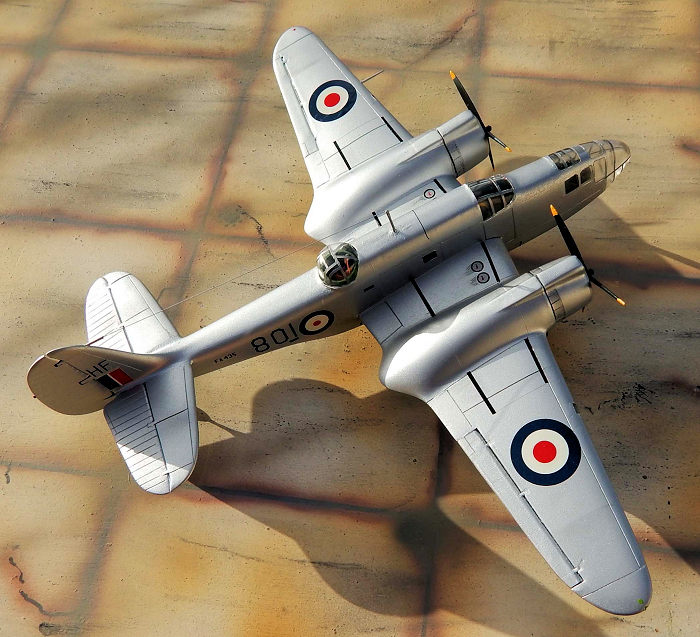 strength was recorded as a mix of three Baltimores and three
Spitfires. More aircraft arrived and Wellington VIII with ASV radar
joined the squadron. By February 1944, 69 Sq found that it was too far
from action and move was made to Montecarvo in Italy. Five Baltimore IVs
and five Mk.Vs flew to their new home on the 7th
February 1944 at the end of most significant period of the squadron’s
life.
strength was recorded as a mix of three Baltimores and three
Spitfires. More aircraft arrived and Wellington VIII with ASV radar
joined the squadron. By February 1944, 69 Sq found that it was too far
from action and move was made to Montecarvo in Italy. Five Baltimore IVs
and five Mk.Vs flew to their new home on the 7th
February 1944 at the end of most significant period of the squadron’s
life.
No.21Sq RAF with Baltimores also visited the station at Hal Far. A tragedy occurred on 9th August when a Baltimore of 21Sq AH173 leaving Hal Far for routine inspection of Castel Benito crashed on take off with the death of all the three crew members. The wing’s final operation was on the 17th August when 11 Boston and 5 Baltimores raided transport targets in the toe of Italy One Boston HK869 returning early with engine trouble crashed at Luqa with the loss of all on board. Two days later the wing left Hal Far and moved to Gerbibi/ Cuticchi in Sicily.
The Baltimore Mk.5.was upgraded with two 1,700 hp (1,268 kW) Wright R-2600-29 radial piston engines, wings fitted with 0.50 in (12.7 mm) machine guns. 600 aircraft of the type were built.The Mk.4, under lend-lease to RAF. Carried four 0.303 in (7.7 mm) Brownings machine guns in the wings. 294 aircraft being built.
Fleet Air Arm 728
Naval Air Squadronn (Baltimore Mk IV - V) Malta: September 1944 -
November 1946. Martin
Baltimore Mk 5 FA435 and FW811 (SOC 31.12.46) formed part of No 728
Fleet Requirement
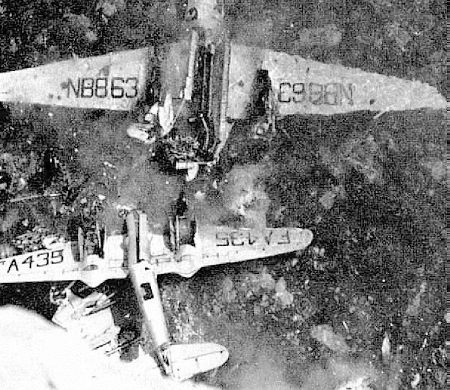 Squadron (Royal Navy). The squadron was formed on 5th
May 1946. The
squadron moved from Ta’Qali to Luqa on 1st
January 1946. 728’s stay at the Luqa station was however destined to be
a short one as it then
moved to Hal Far airfield from Luqa. The type was used for utility as
well as target towing duties.
Squadron (Royal Navy). The squadron was formed on 5th
May 1946. The
squadron moved from Ta’Qali to Luqa on 1st
January 1946. 728’s stay at the Luqa station was however destined to be
a short one as it then
moved to Hal Far airfield from Luqa. The type was used for utility as
well as target towing duties.
In general the squadron was equipped with a mothly collection of Beaufighter Xs, Martinets TT1s, Baltimore Vs, Seafire IIIs, Mosquito XXV, Oxford 1 and Whalrus amphibian. The Mosquitos were used for converting pilots to twin-engined type and for radar calibration duties. At the endof their service life the two Baltimores along with other types were dumped down the cliffs at Hal Far into the Mediterranean sea.
| THE KIT |
The Frog kit moulded in light blue styrene is a good model in spite of age The model is built to represent a Baltimore Mk.5.This is built with decals when it formed part of 728 squadron. Other additional details made to the kit are as follows:
| CONSTRUCTION |
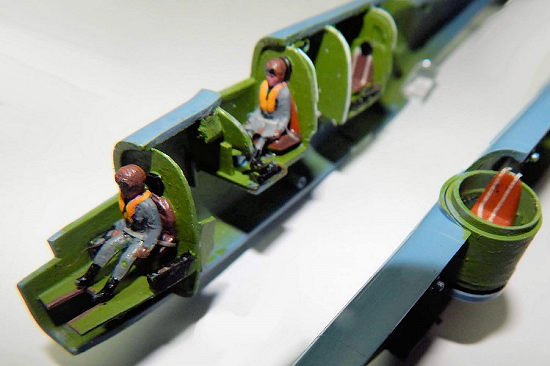 Added partitions and bulkheads to fuselage compartments.
Added partitions and bulkheads to fuselage compartments.
Crew seat and detail to nose interior
Antenna made from metal pin and wireless from thin fishing line.
Made a wider streak on the port fuselage side
Added structural detail to interior of wheel wells
Replaced kit gun turret with a vac form turret from Falcon canopy set.
Removed the guns from turret since this was now used as a target tug with the fleet requirement squadron.
Added circuiting ring in front of radial engines made from stretch sprue and bent in a circle.
Kit was airbrushed with Humbrol silver.
Kit completed with authentic 728 squadron markings, decals came from ‘Kitsatwar’ of Holland.
Photos show the real Baltimore at Hal Far during service and when its service came to an end being dumped down the cliffs at Hal Far into the sea.
This was another Malta based aircraft model I built which continues to show the diversity of types that operated from Hal Far airfield during and after the war years.
27 February 2017
Copyright ModelingMadness.com
If you would like your product reviewed fairly and fairly quickly, please contact the editor or see other details in the Note to Contributors.